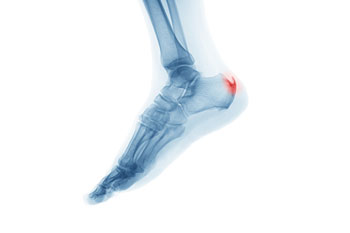
What are Heel Spurs?
Heel spurs, characterized by these bony protrusions, emerge along the underside of the heel bone due to recurring pressure, prompting the body to deposit calcium. This accumulation gradually shapes into sharp extensions on the bone, potentially extending up to half an inch in length.
Understanding Heel Spurs
Causes: Damage or bruising to the heel bone often leads to heel spurs, commonly associated with plantar fasciitis. This condition occurs when the tissue connecting the heels with the toes, known as the plantar fascia, becomes stretched, worn down, or torn, causing irritation at the heel bone insertion site and triggering calcium release over months or years.
Symptoms: Heel spurs are typically asymptomatic and discovered only through X-rays. However, if symptomatic, they can cause intermittent or chronic pain, inflammation, and tenderness at the bottom of the heel.
Heel Spur Risk Factors
Several factors increase the risk of plantar fasciitis and heel spurs, including:
- Excessive body weight or sudden weight gain places prolonged pressure and strain on the affected area.
- Extended periods of standing can also contribute to the issue.
- Additionally, wearing improperly fitting footwear can exert strain on the foot's arch, leading to alterations in one's walking pattern.
- Engaging in repetitive motions or high-impact activities, such as running on hard surfaces, can excessively stretch or wear down the plantar fascia tissue.
- Advancing age can result in reduced flexibility of the plantar fascia and a decrease in the fat pad beneath the heel.
- Individuals with diabetes may experience elevated blood sugar levels, weight gain, and weakening or thickening of the plantar fascia.
- Lastly, having high arches or flat feet can also predispose individuals to heel spur development.
Treatment of Heel Spurs
When treating heel spurs, a podiatrist employs various methods:
Rest and Ice: If experiencing symptoms, icing may be used to alleviate pain and inflammation. Additionally, reducing activities that contribute to heel spur formation and resting the feet can be advised.
Appropriate Footwear and Orthotics: Podiatrists offer expert advice on footwear to relieve symptoms. Custom orthotics may also be prescribed to relieve heel pressure and support the arch.
Taping and Night Splints: Techniques like arch support taping or using night splints can assist in healing the plantar fascia and alleviating symptoms of heel pain and plantar fasciitis.
Physical Therapy: Exercises, strengthening of lower leg muscles, and massage can aid in reducing pain and inflammation while enhancing mobility.
Medication: Over-the-counter oral medications or corticosteroid injections may be recommended to reduce pain and inflammation.
Surgery: In cases where conservative measures fail to provide relief after about a year, surgery to remove the heel spur and address underlying plantar fasciitis may be suggested.
If you suspect you have a heel spur, seek an appointment with a podiatrist for proper diagnosis and treatment.

